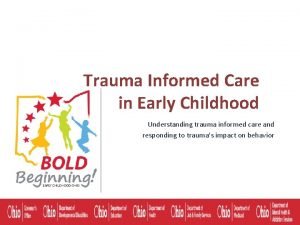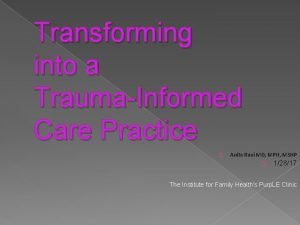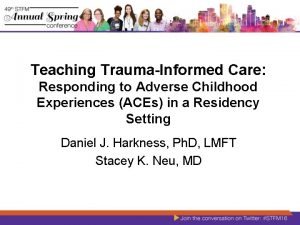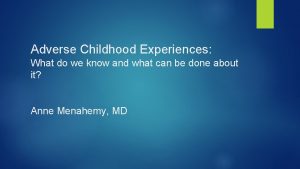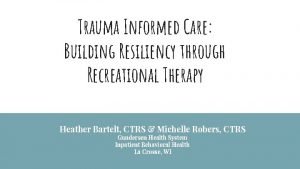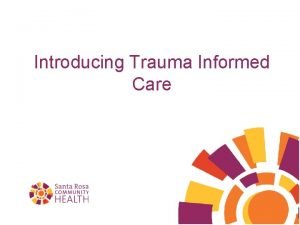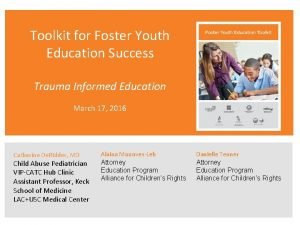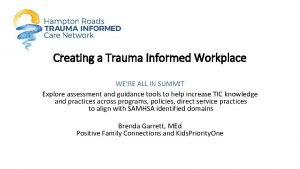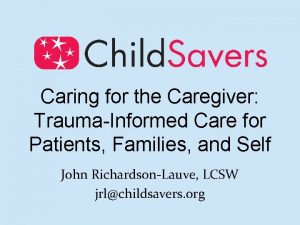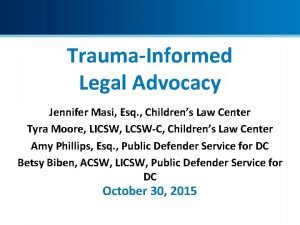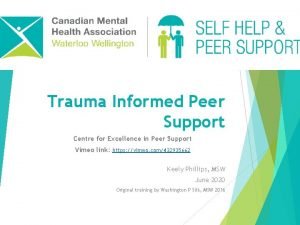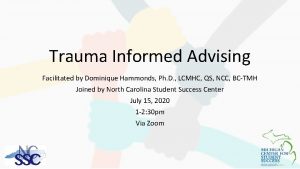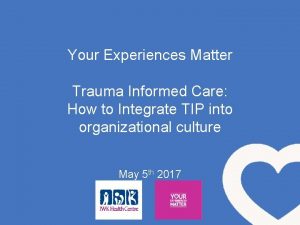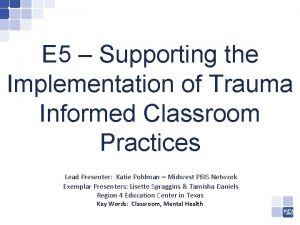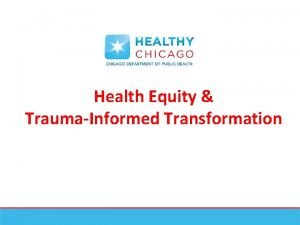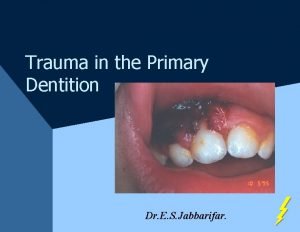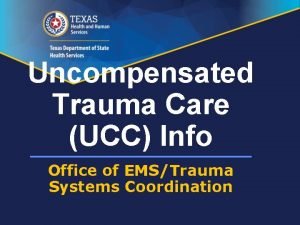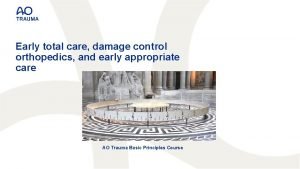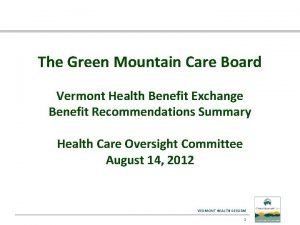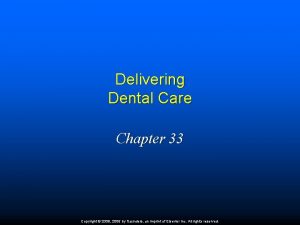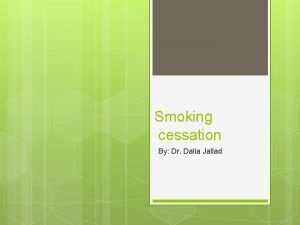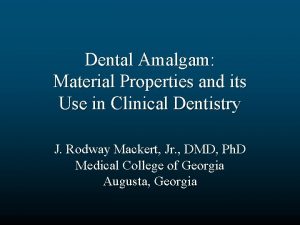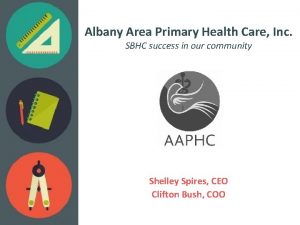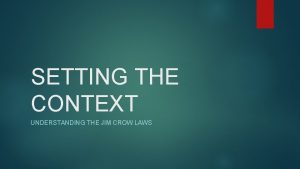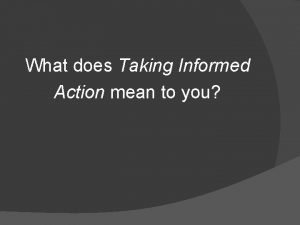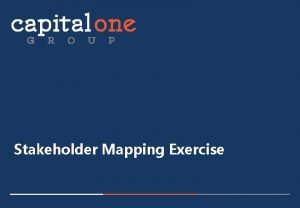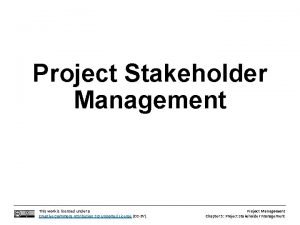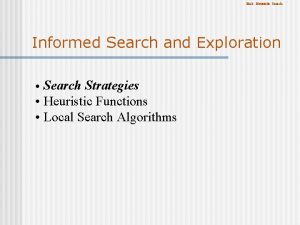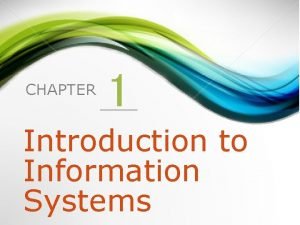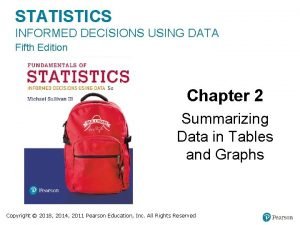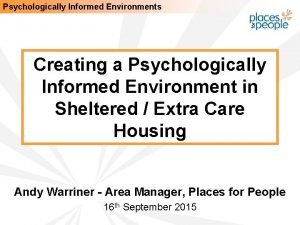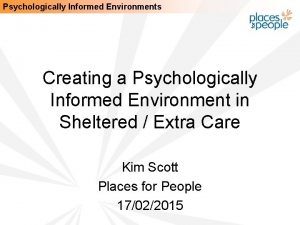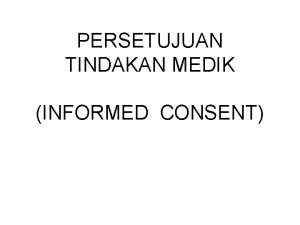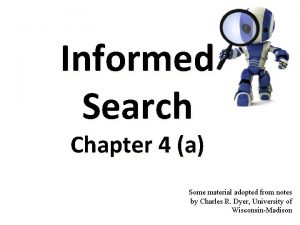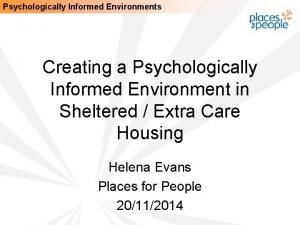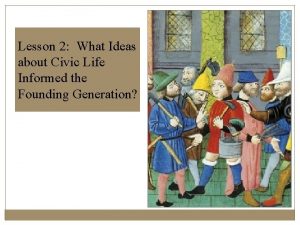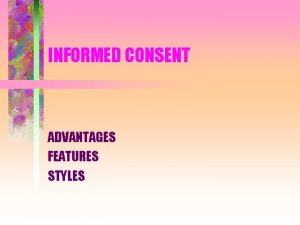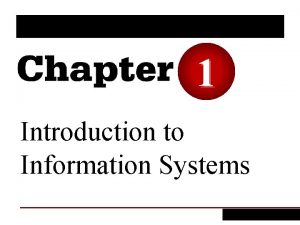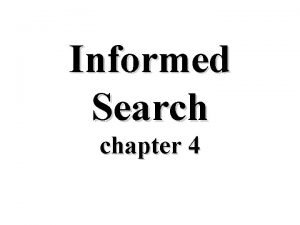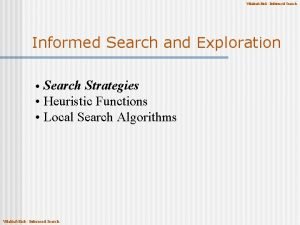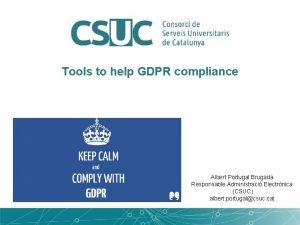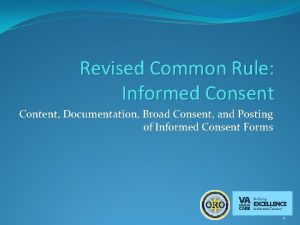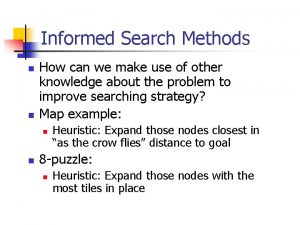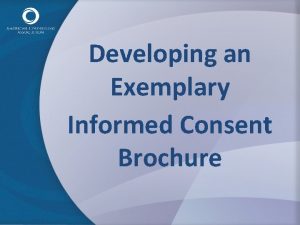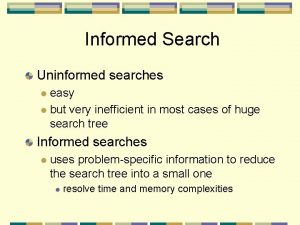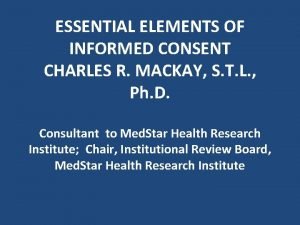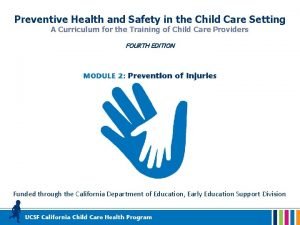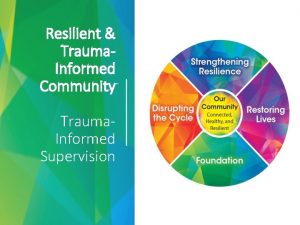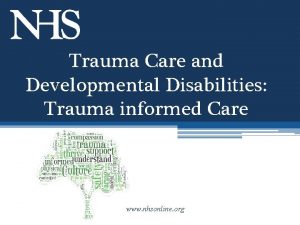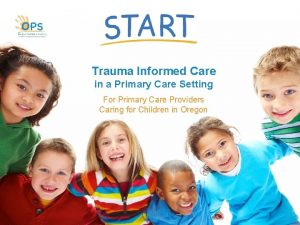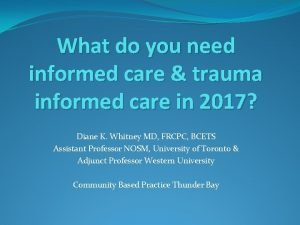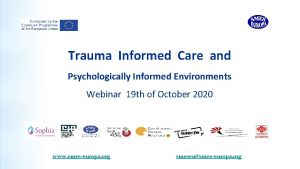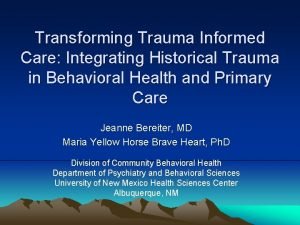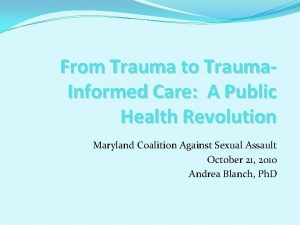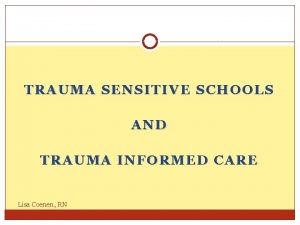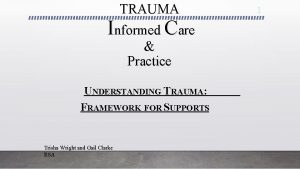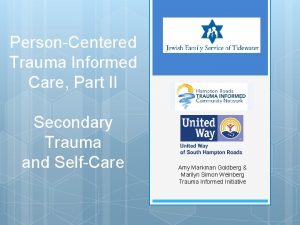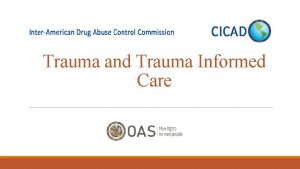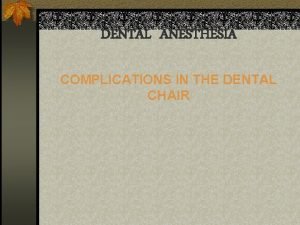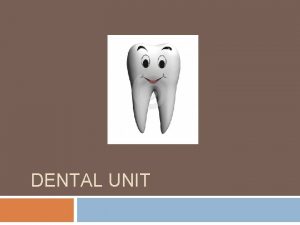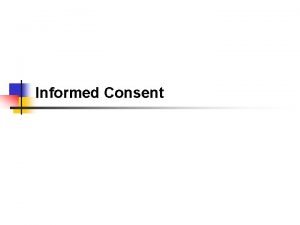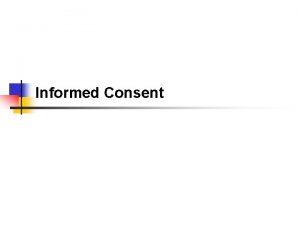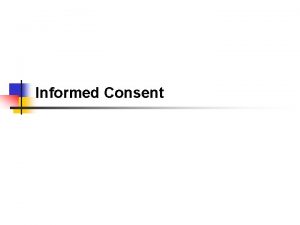Trauma Informed Care in a Dental Setting Why








































































- Slides: 72

Trauma Informed Care in a Dental Setting: Why it Matters/Things You Can Do 2 November 2018 Teri Pettersen, MD teri. pettersen@gmail. com

I have no commercial conflicts of interest

Goals and Objectives • Be aware of the incidence of traumatic experiences in Oregon • Recognize current manifestations of trauma– How does this look ‘walking through your office door’ or ‘in the chair’? • Feel motivated and more comfortable in implementing aspects of trauma informed care in your own setting

In the Next 45 Minutes Trauma: Definitions Statistics How it shows up Trauma Informed Care Definitions Why it is important What you can actually do in your setting

Trauma • Physical Trauma • Emotional/Psychological Trauma

Domestic Violence in Oregon • One in three Oregon women report domestic violence: stalking, physical and/or sexual assault • In 2016, Oregon sexual and domestic violence services answered 139, 580 calls for help • Intimate partner violence accounts for 15% of all violent crime.

In Dental Offices • 87% of dentists do not screen for trauma even when presented with physical signs • • Lack of Education Embarrassment Fear of Offending Patient Partner or children present or in waiting room

The Adverse Childhood Experiences (ACE) study • Vince Felitti, Kaiser • Rob Anda, CDC 17, 421 Kaiser adults

What are ACES? • Abuse of child • Neglect of child • Household dysfunction

What is an ACE Score? • 10 questions • Each positively answered question worth 1 point • Total number of points is your ACE Score




• • • • • Alcoholism and alcohol abuse Chronic obstructive pulmonary disease (COPD) Depression Fetal death Health-related quality of life Illicit drug use Ischemic heart disease (IHD) Liver disease Risk for intimate partner violence Multiple sexual partners Sexually transmitted diseases (STDs) Smoking Suicide attempts Unintended pregnancies Early initiation of smoking Early initiation of sexual activity Adolescent pregnancy Psychotropic Medications Prescribed

ER visits Medical office visits Fractures EARLY DEATH FROM MI

Other recognized traumas • • • Bullying Discrimination Violent neighborhood Foster Care Refugee/Immigrant Status Natural Disasters Person-powered disasters Historical Trauma Medical Trauma

ACE Pyramid

Epigenetics

Gross anatomy

Hypothalamus CRH Cortisol NE DHEA Neuropeptide Y Galanin Testosterone Estrogen PFC CRH Cortisol NE Dopamine 5 -HT GABA Galanin Nucleus Accumbens CRH Dopamine Glutamate Oxytocin Hippocampus Thalamus CRH Cortisol NE 5 -HT GABA BDNF Estrogen Neuropeptide Y Galanin ? DHEA VTA Dopamine Amygdala CRH, Cortisol NE, 5 -HT Dopamine, Glutamate Oxytocin, Galanin Neuropeptide Y • Charney 2004. • Feder A 2009. • Gillespie C 2009. NEUROCHEMISTRY Locus Ceruleus CRH NE Neuropeptide Y Galanin


ACEs are common Household Exposures Alcohol Abuse 24% Mental Illness 19% Drug Abuse 5% Incarceration 3. 4% Childhood Abuse Physical 28% Emotional 11% Sexual 22% (28% women, 16% men) ACE Study

ACEs Cluster 40% reported 2 or more ACEs 12. 5% reported 4 or more ACEs ACE Study

Oregonians with ACE score of Four or Higher: 22%

ACEs Have a dose response relationship with many health problems and behaviors

What We See Is Behavior

What We See is Behavior

What We See Is Behavior

What We See Is Behavior

What We See Is Behavior

“It's hard to get enough of something that almost works. ” - V. Fellitti

Trauma Survivors Are Often High utilizers of sick visits and emergency care Avoidant of preventive care

How This Shows Up • • Poor self-esteem Depression/Anxiety An aversion to being touched Sensitive to boundaries, personal space Distrust Irritability Easily Startled

Trauma Informed Care

Why Trauma Informed Care? • You and your staff can be part of a patient’s healing process • Your patients will have better outcomes • Success begats success

What Gets In The Way?



Personal Sources of Concern • I wasn’t trained to do this • I don’t have time to address this • It is just too complicated • Our own trauma history


NOT ROCKET SCIENCE

A Process Not An Endpoint

• Trauma Sensitive Care • Trauma Informed Care • Trauma Specific Care

Trauma-Sensitive Care A shift from wondering what is wrong with a person that would have them act the way they do to asking what happened to a person that would have them react the way they do.

A Public Health Framework Larger Community Clinic Self Other

Self

Self Care as a practice Erin Fairchild, MSW

And Then There Are Two Self Other

Avoid Re-traumatization

“One does not need to be a therapist to be therapeutic J. Ford, C. WIlson

Radical acceptance

Judgments?

Judgments?

The ‘difficult’ patient/parent • Chronically late or ‘no shows’ • ‘Loses it’ with the front office staff • Complains about anything and/or everything • • Short tempered with their children ‘Non-compliant’ patients Refuse to recline Poor Dental Hygiene

What Can You Do? Understand trauma and triggers: Sights Smells Sounds Body position

What Can You Do? • Acknowledge that some people have dental anxiety/phobia: ASK **Also ask what may have helped in the past**

Then

“Slowly, I have come to see that Asking, and Listening, and Accepting are a profound form of Doing” -Vincent J. Felitti, M. D.

What Can You Do? • • Take Time Active Listening Develop Rapport Share information: rationale for procedures, length of time

Respect Boundaries • Explain who is present • Define roles • Ask if ready to begin

Share Control • Be clear you are working WITH the patient, not simply ON the patient • Ask permission to start • Explain transitions in the procedures and what will come next • Allow breaks • Encourage hand signals

Other Tips Consider blankets Consider weighted blankets Allow support person Offer headphones with music or guided meditation • Acknowledge all success • •

In A Dental Office Clinic Self Other

Trauma Informed Care Not so much about WHAT we do in providing care, but more about HOW we provide that care. Attitudes Language and Cultural Barriers Policies Physical Environment

How a Trauma Informed Office is Different u. Knowledge: All Staff are aware of: vthe prevalence of trauma vits impact on health and well-being u. Safety: All Staff are able to communicate with: v. One another v. Patients v. Families In a manner that feels safe and respectful

u. The Physical Environment: v. Welcoming and Calm u. Patients are Involved and Empowered: v. Clinical decision making v. Feedback is solicited

“The world is moved not only by the mighty shoves of the heroes, but also by the aggregate of the tiny pushes of each honest worker. ” - Helen Keller

Every contact

The Community Larger Community Clinic Self Other

Who Is On Your Side? • • ADA CDC TIO OHA NCTSN AAP AAFP AMA

OPAL Oregon Psychiatric Access Line Psychiatric phone consultation for medical practitioners who treat children, adolescents & adults 9 am to 5 pm, Monday through Friday 855 -966 -7255 (toll-free) or 503 -346 -1000 (Portland metro) register online: www. ohsu. edu/opal fax: 503 -346 -1389 email: opal@ohsu. edu

Thank You
 4 r's trauma informed care
4 r's trauma informed care Trauma informed care lgbtq
Trauma informed care lgbtq Dr anita ravi
Dr anita ravi 4 r's trauma informed care
4 r's trauma informed care 4 r's trauma informed care
4 r's trauma informed care Family enhancement center
Family enhancement center Tina champagne sensory modulation and environment
Tina champagne sensory modulation and environment Trauma-informed care cheat sheet
Trauma-informed care cheat sheet Trauma-informed care activities for staff
Trauma-informed care activities for staff Trauma informed care for foster youth
Trauma informed care for foster youth Trauma-informed workplace assessment
Trauma-informed workplace assessment Trauma-informed questions for clients
Trauma-informed questions for clients Jennifer masi
Jennifer masi Kobtion
Kobtion Trauma informed advising
Trauma informed advising Trauma informed parenting discipline
Trauma informed parenting discipline Trauma informed practice
Trauma informed practice Trauma informed physical environment
Trauma informed physical environment Trauma informed practice
Trauma informed practice Hey hey bye bye
Hey hey bye bye Dr ray padilla
Dr ray padilla Primary care secondary care tertiary care
Primary care secondary care tertiary care Uncompensated trauma care application texas
Uncompensated trauma care application texas Early total care in trauma
Early total care in trauma Dont ask
Dont ask Vermont green mountain care board
Vermont green mountain care board Chapter 33 delivering dental care
Chapter 33 delivering dental care Dr. dalia dental care
Dr. dalia dental care Dalia in the bible
Dalia in the bible Dr. dalia dental care
Dr. dalia dental care Albany area primary health care rural clinic
Albany area primary health care rural clinic Understanding jim crow (setting the setting)
Understanding jim crow (setting the setting) What is informed action
What is informed action Keep satisfied manage closely monitor keep informed
Keep satisfied manage closely monitor keep informed Psychologically informed environment
Psychologically informed environment What is threat matrix
What is threat matrix Free prior and informed consent
Free prior and informed consent Informed (heuristic) search strategies
Informed (heuristic) search strategies An informed guess or assumption about a certain problem
An informed guess or assumption about a certain problem What is informed search and uninformed search
What is informed search and uninformed search Informed user of information systems
Informed user of information systems Statistics informed decisions using data 5th edition pdf
Statistics informed decisions using data 5th edition pdf Psychologically informed environments
Psychologically informed environments Psychologically informed environments
Psychologically informed environments Dasar hukum informed consent adalah
Dasar hukum informed consent adalah Informed search example
Informed search example Best first search
Best first search Http informed delivery usps
Http informed delivery usps Informed delivery campaign
Informed delivery campaign Ethical principles governing informed consent process
Ethical principles governing informed consent process Blind search algorithm example
Blind search algorithm example Informed personal response
Informed personal response Psychologically informed environment
Psychologically informed environment What philosophical ideas informed the founding generation?
What philosophical ideas informed the founding generation? Informed delivery campaigns
Informed delivery campaigns Advantages of informed consent
Advantages of informed consent Informed user of information systems
Informed user of information systems Decision making skills
Decision making skills Examples of informed search
Examples of informed search Informed search
Informed search Slbet portugal
Slbet portugal Broad informed consent
Broad informed consent Informed search
Informed search Informed consent brochure
Informed consent brochure Informed and uninformed search
Informed and uninformed search Essential elements of informed consent
Essential elements of informed consent Preventive health and safety in the child care setting
Preventive health and safety in the child care setting Why was italy a favorable setting for the renaissance
Why was italy a favorable setting for the renaissance Duty of care certificate
Duty of care certificate Magnetul atrage
Magnetul atrage Palliative care vs hospice care
Palliative care vs hospice care Cum se înmulțesc mamiferele
Cum se înmulțesc mamiferele Care sunt simturile prin care sunt evocate
Care sunt simturile prin care sunt evocate
